Mini LED torch review
Nice simple page this one. Just some ramblings on my experiences with 5 LED compact diving lamps.
Having started down the route of cave diving, I needed a number of lamps that could be helmet mounted. This page will review a number that I've purchased,
comparing each along the way and offer a final comparison against the UK C4 eLED lamp.
The lamps that will be covered by this page are:-
Underwater Kinetics UK4 eLED
Aquatec Aqua Star 3W LED
Northern Diver 3W Fusion-X LED
LED Lenser Frogman v2
Consideration will be given to brightness, beam pattern, ease of use and size.
The tests will be split into 2 parts. First, we'll have the measured beam brightness, Secondly, we'll use something that's a little easier to understand
- photographic test.
The Torches
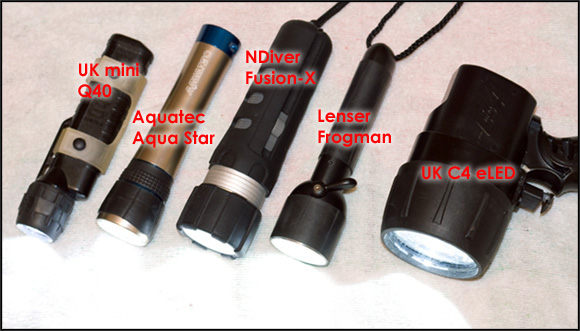
Underwater Kinetics UK40 eLED approx £30
This torch features a 2 watt LED and is powered by 4 AA cells. The torch is operated by twisting the lens cap. The size is very compact at L=155mm,
W=35mm, H=40mm and weighs in at 170g when loaded with Duracell batteries. The case is the traditional tried and trusted heavy duty plastic as used by
UK for years.
Aquatec Aqua Star 3W LED approx £35
This torch features a single 3 watt LED and is powered by 6 AAA cells. The torch is operated by twisting the lens cap. The size is compact at L=160mm,
dia (body)=30mm, dia (head)=40mm and weighs in at 215g when loaded with Duracell batteries. The case is made from anodised aluminium and features double
O-ring sealing.
Northern Diver 3W Fusion-X LED approx
£40
This torch features a single 3 watt LED and is powered by 4 AA cells. The torch is operated by an electronic switch - slide once for on, slide again
to switch off. The size is compact at L=170mm, dia (body)=40mm, dia (head)=50mm and weighs in at 295g when loaded with Duracell batteries. The case
is made from anodised aluminium, is covered in a heavy duty rubber sheath and features double O-ring sealing.
LED Lenser Frogman approx £32 (sadly no longer stocked at 7dayshop)
This torch features a single 3 watt LED and is powered by 4 AA cells. The version 2 torch is operated by a mechanical switch - this is the one to get.
The case is tough ABS with a stainless steel encased bulb unit and is sealed by a single O-ring with an additional rubber sealing surface (not a traditional
O-ring though). The size is very compact at L=155mm, W=35mm, H=25mm, head dia=42mm and weighs in at 225g when loaded with Duracell batteries. Manufacturers
claimed burn time is 50 hrs!
Update The switch is a cause of failure unless you do some preventative maintenance. The magnets and retaining screw will both rust in sea water, eventually causing the switch to become difficult to operate and causing the thing to break. I strongly suggest dismantling the switch and greasing both the screw and the magnets on the underside of the switch. Personally, I used Quicksilva outboard engine grease as that stuff is virtually impossible to remove.
On Test - Light Meter Tests
Each torch was measured using a photographic light meter. The lamp was placed 2m from the meter, with the meter being moved until it falls within the
brightest part of the torch beam (shown by the greatest value of EV).
The Exposure Value was read from the digital meter and from this the Luminance & Illuminance values can be calculated.
Brightness (radiance is the correct measurement, however I'm not using the radiance formula so the term 'radiance' is not used by design) was measured
by letting the light fall directly onto the light sensor within the meter and represents the 'power' of the light source having travelled 2m through
air.
Luminance & illuminance was measured using the same method as above, but included moving a white dome over the sensor to measure the reflected light
or how well the torch will light a subject at 2m in air.
The equations used are: L uminance
(cd/m2) = 2EV-3
Illuminance (lux) = 2.5 x 2EV
Brightness Results
| Torch | EV(max) @ 2m | Luminance |
| Mini Q40 | 10.3 | 158 cd/m2 |
| Aquastar | 12.2 | 588 cd/m2 |
| NDiver | 13.4 | 1,350 cd/m2 |
| Frogman | 13.8 | 1,783 cd/m2 |
Luminance / Illuminance Results
| Torch | EV(max) @ 2m | Luminance | Illuminance |
| Mini Q40 | 4.2 | 2.3 cd/m2 | 46 lux |
| Aquastar | 6.1 | 8.6 cd/m2 | 172 lux |
| NDiver | 7.2 | 18.4 cd/m2 | 368 lux |
| Frogman | 7.6 | 24.3 cd/m2 | 485 lux |
From these tables, we can see that the Frogman produces the greatest light intensity.
Numbers are all well and good, but a picture paints a 1000 words....
On Test - Photographic Tests
The photo tests are presented below. 2 sets were run (shot in my garden at night). The first where the shutter speed is locked at 1 sec, ISO=1600 and the camera being allowed to select the aperture. The aperture setting will give a rough guide of the amount of light emitted by the torches as the camera will try to get the same exposure in each photo. In all photos, the distance between the target and the torch / camera is 10m.
The results will be discussed later.
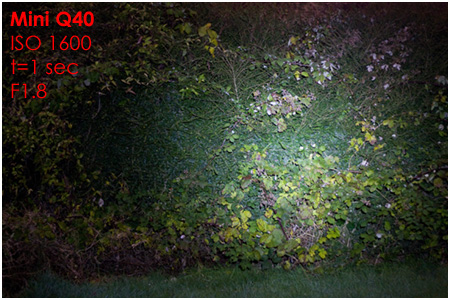
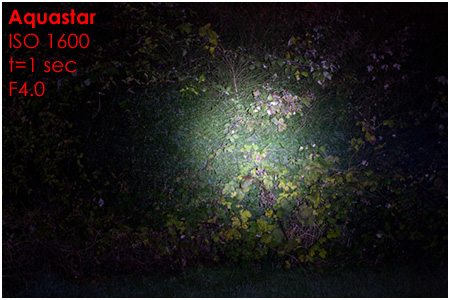


Ok, what does this show?
The camera will try to expose each picture the same, so the F number can be used to compare the relative brightness of each image. I've done this as this is kind of what your eyes will also do.
There is a good page about F stops on wiki, which explains the relationship, however what we need to know is that an increase of 1 stop means there is twice as much light hitting the camera.
From the scale on the link, and using the Q40 as the baseline, we see that the Aquastar is 2 1/3 stops brighter, or 2.333 times brighter than the mini Q40
We can put this lot into a simple table to get an approximation as to the brightness of each lamp.
| Torch | F stop | v Q40 | v Aqua | v Ndiv | v Frog |
| Mini Q40 | 1.8 | 1x | 0.43x | 0.37x | 0.3x |
| Aquastar | 4.0 | 2.333x | 1x | 0.75x | 0.5x |
| NDiver | 4.5 | 2.666x | 1.333x | 1x | 0.6x |
| Frogman | 5.6 | 3.333x | 2x | 1.666x | 1x |
We can see from the results that the Frogman is the brightest of them all, but from the photos, we can also see the difference in beam pattern.
The Aquastar and the Frogman are very similar, but the output from the Frogman is around twice as 'hot' as the Aquastar (F4 --> F5.6 is 1 stop of light = twice as much light)
The NDiver has the best beam spread of the brighter torches, but this spread comes at the cost of the beam not being so bright. The mini Q40 has the best beam spread of them all, but it is considerably dimmer than all of the others
You need to bear in mind that this is a very Heath Robinson approach and is a rough-ish guideline only.
The 2nd set of photos have the camera locked at 1sec shutter speed, ISO 1600 and aperture of F5.6. The resulting photos are shown below.
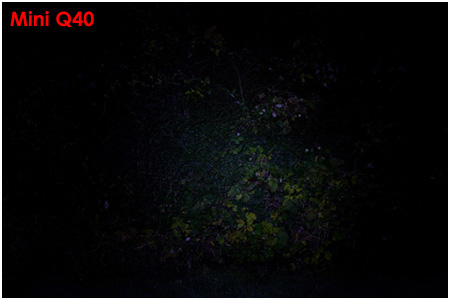
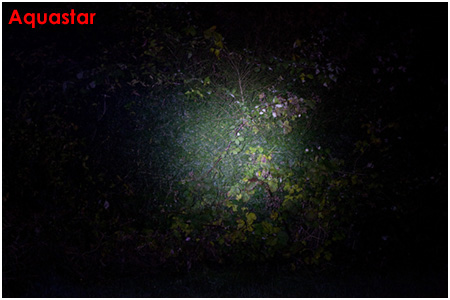
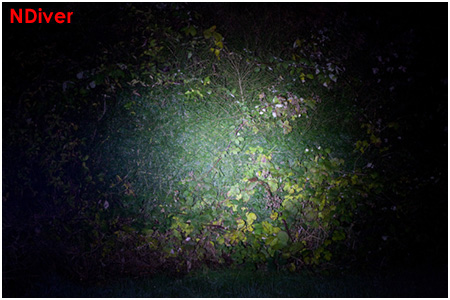
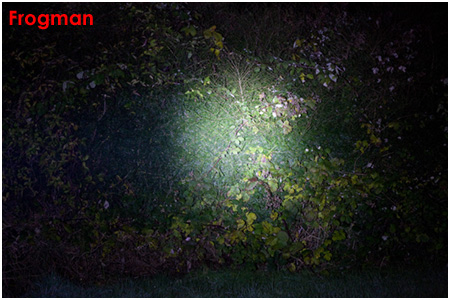
And animated, we get this...

Here , we can see the relative brightness of each torch and also the beam pattern and are generally more meaningful than that lovely table above as you can actually see the difference for yourself. What is evident is that the Frogman has a degree of 'spill' that isn't present with the NDiver which is useful for peripheral vision
Opinions
Of the 4 torches, I'd recommend the Q40 in the role of last ditch backup / gauge reading / camera spotting light. It is considerably better than the filament based offering it replaced but lacks the oomph of the other torches on offer here.
The Aqua star was promising but falls down on the twist on/off control mechanism as this will no doubt lead to some people flooding the unit. The double o-ring is a good security feature, however the lamp just lacked the brightness shown by it's brethren using the same 3W LED. Another potential sticking point is the use of 6 AAA batteries as the power source. On the plus side, it is easily helmet mounted and relatively easy to operate with gloved hands.
The Northern Diver looks a good solid unit and has the widest beam spread of the torches here. Due to the extra couple of degrees of beam spread, the brightness on distant objects is reduced, but closer objects are better lit. The double o-rings again add a good degree of confidence. The electronic switch is a nice feature, but is obscured / protected by the heavy duty rubber molding protecting the torch, making the switch difficult to operate with gloved hands. Trying to find the switch by feel alone is difficult with bare hands. With gloved hands it's very difficult.
As the largest torch here, helmet mounting is still easy and the torch is easily secured thanks to the ridges in the rubber protector.
The Lenser Frogman offers the brightest beam due to it being relatively narrow. The mechanical switch is very tactile and sized to be easily located and operated wearing thick gloves in darkness. The screw holding the switch together will corrode quickly so could do with a spot of silicon grease smearing over it's surfaces. There are a few versions of this torch on the market. The one reviewed here is the v2. Version 1 had a twist to operate mechanism and should ideally be avoided as you run the flooding risk, the lamp-being-turned-on-by-accident-whilst-in-a-pocket risk and the build quality was allegedly a bit random.
Testers Choice
I use the mini Q40 as a spotting / focusing torch mounted to my camera flash, however the winner in this mini test is the Lenser Frogman. Its beam is the brightest (and narrowest), however the super tactile switch is what clinches it over the Northern Diver. Add to that the claimed burn time of 50hrs (that's 2 complete weeks of diving in the Red Sea, not just the 5hrs or so of night dives) and you've got a bit of kit that offers superb value for money. It is sufficiently compact to be easily storable in a BCD pocket or within a wing shoulder strap cover. It's clearly not going to compete with a HID setup or one of the Fami triple LED torches, but for an inexpensive backup or as part of a helmet mounted lighting solution, it's highly recommended.
Comparison with the UK C4 eLED
Having chosen the Lenser Frogman as the pick of the (small) bunch, how does it compare with the Underwater Kinetics UK C4 eLED?
A review of that particular torch can be found here.
The photo below shows the C4 (at full power) and the Frogman using the same fixed exposure test conditions as before.
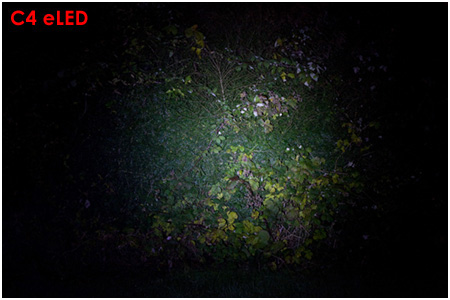

We can see that the C4 (weigh= 680g with batteries) offers a wide beam but is not as bright as the Frogman nor the NDiver.
This may be due to the batteries in the C4 being of an unknown age, however the C4 I have is at least 4 years old and technology has progressed a little since then.
What is clear is that the Frogman punches way above it's weight and represents a good choice as a lightweight travel option or for helmet mounting and subsequent use in overhead environments.
| v1.2 | 29th May 2010 | Frogman switch failure notes added. |
| v1.1 | 14th Nov 2008 | Light meter test results added. |
| v1 | 11th Nov 2008 | Page created |